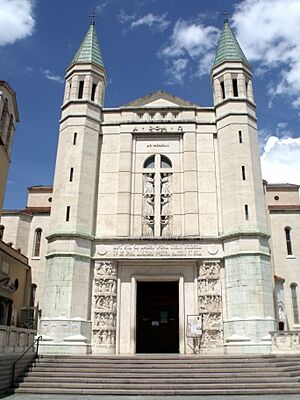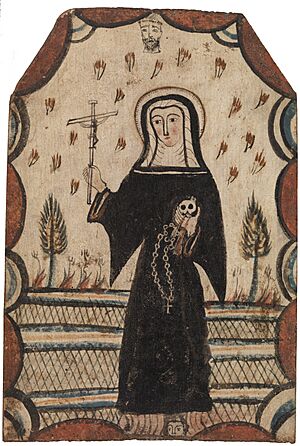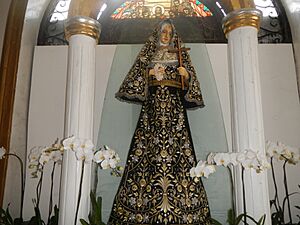Rita of Cascia facts for kids
Quick facts for kids SaintRita of Cascia, O.S.A. |
|
|---|---|

Portrait of St. Rita, detail of the chest that contained the body, Sanctuary of Cascia.
|
|
| Widow and Religious | |
| Born | 1381 Roccaporena, Perugia, Papal States |
| Died | 22 May 1457 (aged 75–76) Cascia, Perugia, Papal States |
| Venerated in | Catholic Church |
| Beatified | 1626 by Pope Urban VIII |
| Canonized | 24 May 1900, St. Peter's Basilica by Pope Leo XIII |
| Major shrine | Basilica of Santa Rita da Cascia, Cascia, Perugia, Italy |
| Feast | 22 May |
| Attributes | Forehead wound, rose, bees, grape vine |
| Patronage | Lost and impossible causes, sickness, wounds, marital problems, abuse, mothers |
| Controversy | Spousal abuse, feud, family honor, loneliness |
Rita of Cascia (born Margherita Ferri Lotti; 1381 – 22 May 1457) was an Italian woman who became a nun. She is known for her deep faith and for helping to solve difficult problems.
After her husband passed away, Rita joined a group of nuns. She was known for her strong prayers and devotion. Many people believe that miracles happened because of her prayers. She is often shown with a small wound on her forehead. This wound is thought to be a special sign of her connection to Jesus.
Pope Leo XIII made Rita a saint on May 24, 1900. Her special day, called a feast day, is celebrated every year on May 22. When she became a saint, she was given the title "Patroness of Impossible Causes." This means she is seen as a helper for very tough situations. In many Catholic countries, she is also known as a helper for people facing problems in their marriage or feeling heartbroken. Her body rests in the Basilica of Santa Rita da Cascia in Italy.
Contents
Rita's Early Life
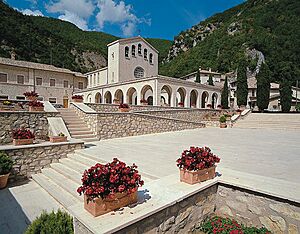
Margherita Lotti was born in 1381 in a small village called Roccaporena. This village is close to Cascia, in a region of Italy called Umbria. Many people visit these places today because they are connected to her life. Her name, Margherita, means "pearl." People lovingly called her Rita, which is a shorter version of her name.
Her parents, Antonio and Amata Ferri Lotti, were known for being kind and helpful. They were even called "Peacemakers of Christ" because they helped people get along.
When Rita was twelve, her parents arranged for her to marry a nobleman named Paolo Mancini. This was a common practice at the time. Rita had wanted to become a nun, but she followed her parents' wishes. Her husband, Paolo, was a wealthy man. He was known for having a difficult personality and many enemies in the Cascia area.
Rita's marriage lasted for eighteen years. During this time, she was a loving wife and mother. She tried hard to help her husband change his unkind behavior. Rita patiently dealt with his insults for many years. Stories say that her kindness and patience helped Paolo become a better person. He even gave up a long-standing family quarrel known as La Vendetta.
Rita and Paolo had two sons, Giangiacomo and Paulo. She raised them to follow Christian values. As time passed, the family quarrel between the Chiqui and Mancini families grew more intense. Even though Paolo had changed, his enemies betrayed him. He was killed by Guido Chiqui, a member of the rival family.
At Paolo's funeral, Rita publicly forgave the people who killed her husband. Paolo Mancini's brother, Bernardo, convinced Rita's sons to live with him. Rita's sons wanted to get revenge for their father's death. However, they both sadly passed away from a sickness.
After her husband and sons died, Rita wanted to join the monastery of Saint Mary Magdalene in Cascia. But the nuns there turned her away. They knew Rita was a good person, but they were worried about being connected to her because of her husband's violent death.
Rita did not give up. The nuns told her she could join if she could make peace between her family and her husband's killers. She prayed to her three special saints: John the Baptist, Augustine of Hippo, and Nicholas of Tolentino. She then worked to bring peace between the fighting families in Cascia.
Stories say that a terrible sickness, the bubonic plague, helped her. It infected Bernardo Mancini, her husband's brother. This made him give up his desire for revenge. Rita was able to solve the conflicts between the families. At the age of thirty-six, she was finally allowed to enter the monastery.
Some religious stories say that Rita was magically carried into the monastery by her three patron saints. She stayed at the monastery, following the Augustinian Rule, until she passed away from tuberculosis on May 22, 1457.
Becoming a Saint
An Augustinian priest named Agostino Cavallucci wrote the first story of Rita's life. He based it on what people remembered and said about her. This book was published in 1610.
Rita was officially declared "blessed" by Pope Urban VIII in 1626. A close friend of the Pope, Fausto Poli, was born near Rita's hometown. He was very enthusiastic about her story, which helped her become well-known.
Rita was made a saint on May 24, 1900, by Pope Leo XIII. Her feast day is celebrated on May 22. In 2000, Pope John Paul II spoke about Rita. He said she showed amazing qualities as a Christian woman. She lived out the "feminine genius" by being a mother both physically and spiritually.
Rita is known, along with St. Philomena and St. Jude, as a saint for impossible causes. She is also seen as a helper for people who have been hurt, feel lonely, have marriage problems, or are sick.
Augustinians believe that Rita's body has remained well-preserved over many centuries. It is honored today in the special church in Cascia named after her. Many people from all over the world visit her tomb each year.
Special Symbols of Saint Rita
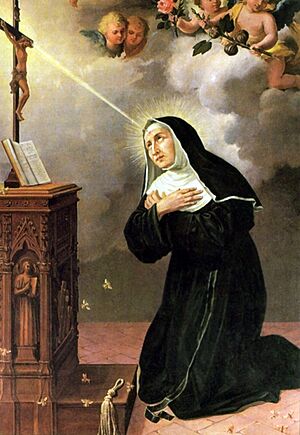
Several religious symbols are connected to Saint Rita. She is often shown holding a thorn or a crown of thorns. This represents her deep devotion and the special wound on her forehead. She is also often seen holding a large Crucifix or with roses nearby. Sometimes, she is shown with a palm leaf and three crowns, representing her two sons and husband. Other images show her with two small children (her sons), a Gospel book, and a skull, which is a symbol of life and death.
The Forehead Wound
When Rita was about sixty years old, she was praying in front of a picture of Jesus on the cross. Suddenly, a small wound appeared on her forehead. It was as if a thorn from Jesus' crown had come off and touched her skin. This was seen as a special sign of her closeness to Christ. She had this wound until she died in 1457.
Roses
It is said that near the end of her life, Rita was very sick in the convent. A cousin visited her and asked if she wanted anything from her old home. Rita asked for a rose from the garden. It was January, a time when roses do not usually bloom. Her cousin did not expect to find one. However, when her relative went to the house, a single blooming rose was found in the garden. The cousin brought it back to Rita at the convent.
Because of this story, Saint Rita is often shown holding roses or with roses nearby. On her feast day, churches and shrines dedicated to Saint Rita give out roses. These roses are blessed by a priest during Mass.
The Bees

In a church in Belgium, there is a statue of Rita that includes several bees. This comes from a story about her baptism as a baby. The day after she was baptized, her family saw a swarm of white bees flying around her crib while she slept. The bees peacefully went in and out of her mouth without hurting her. Her family was amazed by this sight. This event was believed to show that Rita's life would be filled with hard work, goodness, and devotion.
Rita's Legacy
In the 20th century, a large church was built for Rita in Cascia. This church and the house where she was born are very popular places for people to visit on pilgrimages in Umbria.
The National Shrine of Saint Rita of Cascia in Philadelphia, Pennsylvania, was built in 1907. It is also a popular place for people to visit and pray.
French singer Mireille Mathieu chose Rita as her special saint. This was on the advice of her grandmother. In her autobiography, Mathieu wrote about buying a candle for Rita with her last money. Mathieu says that even though her prayers were not always answered, they helped her become a strong and determined woman.
In 1943, a film called Rita of Cascia was made about her life. Another film, Santa Rita da Cascia, was made in 2004 in Italy. This film helped make Rita's story even more popular.
Rita is sometimes unofficially called the patron saint of baseball. This is because she was mentioned in the 2002 movie The Rookie.
The 2019 science fiction story Sisters of the Vast Black features a fictional group of nuns called the Order of Saint Rita.
St. Rita's Church in Nanthirickal, India, is the only church in Asia that has special items (relics) belonging to Saint Rita. It is also the only Catholic church in Kerala named after her.
See also
 In Spanish: Rita de Casia para niños
In Spanish: Rita de Casia para niños
- List of saints canonized by Pope Leo XIII
- Saint Rita of Cascia, patron saint archive


